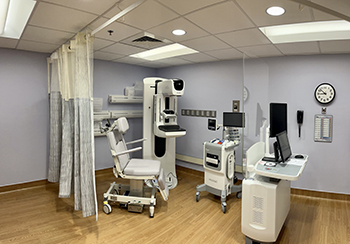
Picture of room with 3D mammography equipment.
Imaging Services/Nuclear Services
Ashe Memorial Hospital is proud to offer some of the most advanced imaging services available. These tools help medical providers quickly assess your medical issues and begin treatment promptly. To learn more about any of the tests below, or to schedule an appointment, call 336-846-0820.The imaging services offered at Ashe Memorial Hospital include:
Nuclear Medicine
Nuclear medicine testing involves using radioactive isotopes to measure the function of organs within the body. The isotopes are swallowed or injected, and then a special camera tracks their movement through the body.
CT Scans
A CT scan, or CAT scan, uses an X-ray to create cross sectional "slices" of structures inside the body. This involves multiple passes through a CT scanner and is usually non-invasive.
Ultrasound
An ultrasound is a tool that uses sound waves to create pictures of structures within the body, including organs and fetuses. Moving images can be viewed on a video screen while still images can be captured for later viewing.
Mammography
One of the most powerful tools in the diagnosis and treatment of breast cancer, mammography creates a digital image of tissues within the breast.
Magnetic Resonance Imaging (MRIs)
Ashe Memorial Hospital offers in-house magnetic resonance imaging services. MRIs use powerful magnets and radio waves to create images of structures inside the body including the brain, spine and joints. MRI services are available at Ashe Memorial Hospital three days a week.
X-Rays
X-rays are beams that create pictures of bones and hard structures in the body. This basic diagnostic tool is often used to assess broken bones.
Bone Density (DEXA) Scans
Bone density scans, or DEXA scans, use X-rays to assess bone health and compare results to bone density information based on age and gender. This tool is used to assess a patient's risk of the bone-weakening disease osteoporosis.



